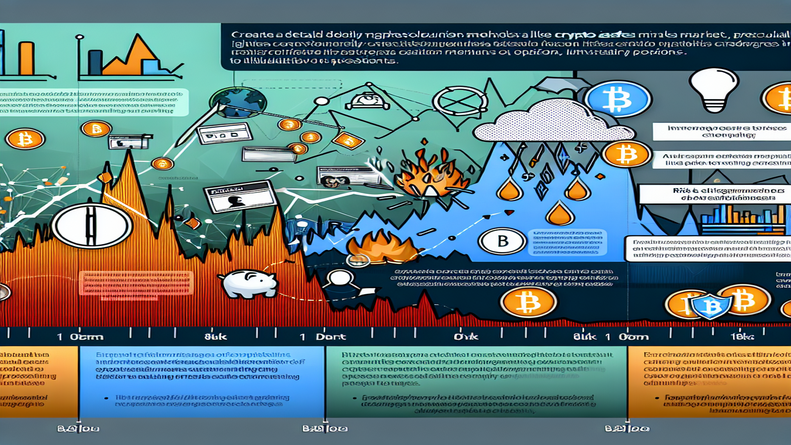Venturing into the crypto asset management realm presents a unique set of challenges that differ widely from the traditional fund space. In the wake of FTX’s collapse, the scrutiny of Caroline Ellison’s dismissive attitude towards stop losses has triggered a debate on the effectiveness of traditional risk management tools in the volatile cryptocurrency market. This primer peels back the layers of complexity that aspiring fund managers face in launching a bitcoin sector fund, and highlights the stark departures from traditional asset management.
🎢 Embracing Volatility: The Perils and Prospects
One of the most significant challenges faced by bitcoin sector funds is the notorious volatility within the cryptocurrency market. Bitcoin, for instance, has been at the center of epic bullish runs generating investor buzz, as well as devastating crashes that have wiped out fortunes overnight. This relentless unpredictability demands a departure from conventional risk management
where traditional tools like stop losses can fail spectacularly, giving way to more nuanced approaches.
Fund managers need to arm themselves with an array of sophisticated strategies that accommodate sudden price shifts without jeopardizing the entire portfolio. These include employing hedging techniques like options trading, taking advantage of insurance-like put options to establish a floor for losses, and sometimes, completely liquidating positions ahead of known volatility catalysts to weather the storm.
🔐 Custodial Conundrums: Navigating the Wilds of Crypto Security
A paramount consideration for fund managers in the crypto sector is the custody and security of digital assets. Unlike traditional asset systems with standardized custody and settlement processes, bitcoin exchanges serve multiple roles – leading to a significant concentration of counterparty risk.
A fund manager’s mandate in the crypto space extends beyond financial acumen to include technical prowess in managing and securing private keys, and meticulously evaluating the integrity of trading venues to prevent hacks and security breaches. Robust measures like multi-signature protocols and cold storage are not merely advisable but imperative to sustain investor confidence and ensure the long-term viability of the fund.
🔄 Market Mechanics: Stepping Outside the Traditional Paradigms
 In traditional finance, blue chip assets typically enjoy relative price stability. Conversely, the cryptocurrency market can see drastic price movements within hours, mandating a radical recalibration of market engagement strategies. Fund managers must proactively engage with a perpetually evolving landscape, factoring in everything from potential regulatory shifts, technological developments, and global economic trends that can spur unexpected market behavior.
In traditional finance, blue chip assets typically enjoy relative price stability. Conversely, the cryptocurrency market can see drastic price movements within hours, mandating a radical recalibration of market engagement strategies. Fund managers must proactively engage with a perpetually evolving landscape, factoring in everything from potential regulatory shifts, technological developments, and global economic trends that can spur unexpected market behavior.
Dynamic trade sizing, leverage adjustments, and proactive risk-adjusted portfolio allocations become vital tools in the crypto fund manager’s arsenal – augmenting the traditional focus on the mere ebb and flow of asset values.
💡 Innovations in Risk Assessment: Finding New Pathways to Stability
Caroline Ellison’s skeptical standpoint on stop losses as a risk management tool in the crypto context may have a grain of truth; these traditional techniques can indeed falter amid crypto’s extreme market behavior. This prompts a reevaluation and a potential paradigm shift towards innovative risk assessment frameworks.
An integrated approach, blending analytical prowess with a keen understanding of crypto market dynamics, enables a proactive rather than reactive stance to risk. It empowers fund managers to hedge against drastic downturns while capturing upside potential, aligning investor expectations with the real behavior of crypto markets.
🌟 The Art of Adaptability: Crafting a Resilient Bitcoin Sector Fund
Launching and maintaining a successful bitcoin sector fund is as much about adaptability and resilience as it is about financial skill. Understanding the nuances of the crypto market, deploying appropriate risk management practices, and ensuring the secure custody of assets are the foundational pillars for budding fund managers in this arena.
The road ahead for aspirants is far from straightforward – with fund closures often matching launches each quarter – but, imbued with entrepreneurial spirit and informed strategies, the opportunities within the burgeoning digital asset market can lead to extraordinary outcomes.
💬 Concluding Insights: Navigating Uncharted Waters
Escaping the gravitational pull of traditional asset management to break into the realm of bitcoin-oriented funds is, undeniably, an exhilarating venture. It is essential, however, for fund managers to arm themselves with a robust understanding of the complexities and inherent risks that frame this new frontier.
By embracing an informed, adaptive approach and maintaining a steadfast focus on sound risk management practices, fund managers can forge a path to success in the crypto sector. And for those fueled by a pioneering spirit and a willingness to delve deep into uncharted territories, the cryptosphere offers boundless opportunities.Are you ready to join the movement and redefine the scope of what’s possible within your organization? Connect with me on LinkedIn to explore how you can navigate the complexities of crypto asset management and uncover the potential rewards of this dynamic market. 🚀🌟
